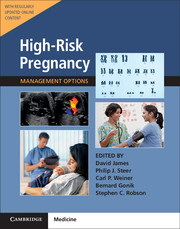Book contents
- High-Risk Pregnancy: Management Options
- High-Risk Pregnancy: Management Options
- Copyright page
- Contents
- Contributors
- Section 1 Prepregnancy Problems
- Section 2 Early Prenatal Problems
- Section 3 Late Prenatal – Fetal Problems
- Section 4 Problems Associated with Infection
- Chapter 24 Hepatitis Virus Infections in Pregnancy (Content last reviewed: 23rd July 2019)
- Chapter 25 Human Immunodeficiency Virus in Pregnancy (Content last reviewed: 23rd July 2019)
- Chapter 26 Rubella, Measles, Mumps, Varicella, and Parvovirus in Pregnancy (Content last reviewed: 11th November 2020)
- Chapter 27 Cytomegalovirus, Herpes Simplex Virus, Adenovirus, Coxsackievirus, and Human Papillomavirus in Pregnancy (Content last reviewed: 11th November 2020)
- Chapter 28 Parasitic Infections in Pregnancy (Content last reviewed: 15th June 2018)
- Chapter 29 Other Infectious Conditions in Pregnancy (Content last reviewed: 11th November 2020)
- Section 5 Late Pregnancy – Maternal Problems
- Section 6 Late Prenatal – Obstetric Problems
- Section 7 Postnatal Problems
- Section 8 Normal Values
- Index
- References
Chapter 25 - Human Immunodeficiency Virus in Pregnancy (Content last reviewed: 23rd July 2019)
Published online by Cambridge University Press: 15 November 2017
- High-Risk Pregnancy: Management Options
- High-Risk Pregnancy: Management Options
- Copyright page
- Contents
- Contributors
- Section 1 Prepregnancy Problems
- Section 2 Early Prenatal Problems
- Section 3 Late Prenatal – Fetal Problems
- Section 4 Problems Associated with Infection
- Chapter 24 Hepatitis Virus Infections in Pregnancy (Content last reviewed: 23rd July 2019)
- Chapter 25 Human Immunodeficiency Virus in Pregnancy (Content last reviewed: 23rd July 2019)
- Chapter 26 Rubella, Measles, Mumps, Varicella, and Parvovirus in Pregnancy (Content last reviewed: 11th November 2020)
- Chapter 27 Cytomegalovirus, Herpes Simplex Virus, Adenovirus, Coxsackievirus, and Human Papillomavirus in Pregnancy (Content last reviewed: 11th November 2020)
- Chapter 28 Parasitic Infections in Pregnancy (Content last reviewed: 15th June 2018)
- Chapter 29 Other Infectious Conditions in Pregnancy (Content last reviewed: 11th November 2020)
- Section 5 Late Pregnancy – Maternal Problems
- Section 6 Late Prenatal – Obstetric Problems
- Section 7 Postnatal Problems
- Section 8 Normal Values
- Index
- References
Summary
The management of human immunodeficiency virus (HIV) infection continues to evolve rapidly. Amazing advances have been made in therapy of primary infection, prevention of opportunistic infections, and prevention of perinatal transmission since the first cases of acquired immune deficiency syndrome (AIDS) were described in 1981. Perinatal transmission rates have decreased from 20–30% early in the epidemic to < 1% in high-income countries with the use of antiretroviral therapy and scheduled cesarean delivery.
- Type
- Chapter
- Information
- High-Risk PregnancyManagement Options, pp. 621 - 643Publisher: Cambridge University PressFirst published in: 2017



